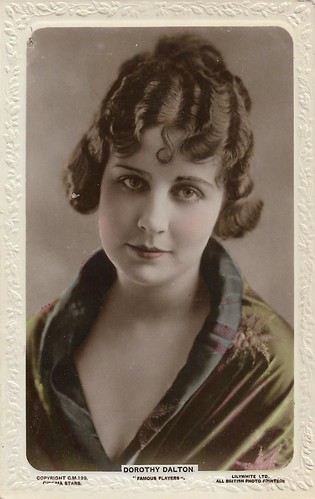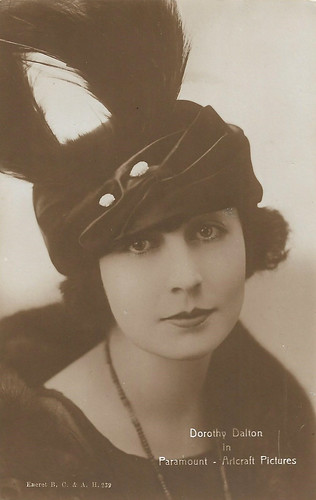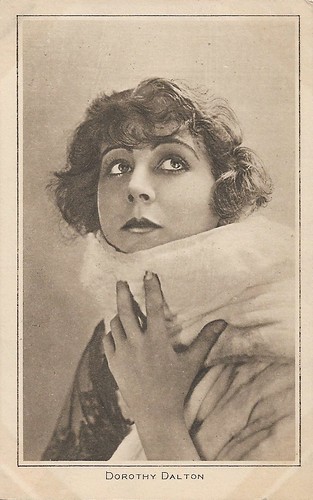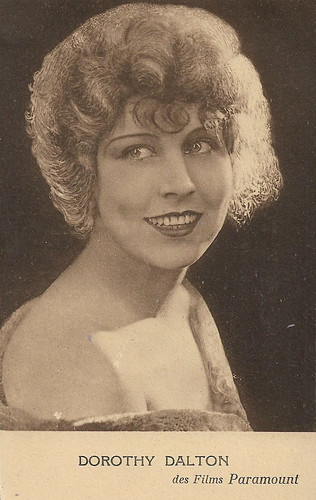Dorothy Dalton (1893-1972) was an American actress on the silent screen, who was a huge film star in the 1920s. She acted at such studios as Kay-Bee, Thomas Ince Corp, and Famous Players / Paramount.

British postcard by Lilywhite Ltd. in the 'Famous Players' series.

Swedish postcard by Eneret B.C. & A.H., no. 239. Photo: Paramount - Artcraft Pictures.

French postcard by Cinémagazine-Edition, no. 130.
Dorothy Dalton was born in Chicago, Illinois, in 1893. In 1910, Dalton began her career as a theatre actress. She became part of stock companies in Chicago, Terre Haute (Indiana) and Holyoke (Mass.), and worked for the vaudeville circuit Keith-Albee-Orpheum.
In 1914 she arrived in Hollywood, making her screen debut in the film Pierre of the Plains (dir. unknown, 1914) alongside Edgar Selwyn, one of the protagonists of the American theatre scene of the early twentieth century, but also one of the founders of Goldwyn Pictures.
In 1915 Dalton starred alongside William S. Hart in The Disciple (William S. Hart, Clifford Smith, 1915), followed by the role of Queen Anne in the 1916 version of The Three Musketeers (Charles Swickard, 1916) for Kay-Bee Pictures, starring Orrin Johnson as D'Artagnan.
At Kay-Bee Pictures Dalton starred in numerous films produced by Thomas H. Ince, the powerful Hollywood producer who died so mysteriously in 1924. Her directors at Kay-Bee were Charles Miller, Raymond West, and Roy William Neill. In 1917 she appeared e.g. in The Price Mark and Love Letters, both directed by Roy William Neill but supervised by Thomas Ince. Here she starred alongside William Conklin.
She also acted in Unfaithful (Charles Miller, Thomas Ince, 1918), one of the last films directed by Ince before he devoted himself entirely to production. In 1918 Ince founded his own Thomas Ince Corporation, where Dalton continued to star in films now directed by Victor Schertzinger and Joseph De Grasse. Paramount distributed the films. Between 1917 and 1919 Dalton would do 8 to 10 films per year, always in the lead. Altogether Thomas Ince and Dorothy Dalton collaborated on 31 films between 1915 and 1920.

British postcard by 'Pictures' Portrait Gallery, London, no. 23. Photo: Apeda / Paramount.

British postcard in the 'Pictures' Portrait Gallery, by Pictures Ltd., London, no. 167.
By 1920 Dorothy Dalton would move to Famous Players, Paramount's own production company. In 1921 she had the lead in Cecil B. DeMille's Fools Paradise, about a girl (Dalton) madly in love with a man (Conrad Nagel), who loves another (Mildred Harris). When he gets blind, the girl pretends she is the other woman. This goes well until he regains his sight ... (it is incredible how many people regain sight in the movies).
Dalton's star status was so big in the early 1920s that she was allowed to have her name in front of the film title. So it happened that, in 1922, the advertisement of Moran of the Lady Letty showed the name of Dorothy Dalton in evidence, while that of Rodolfo (Rudolph) Valentino, at the time in strong ascent but still considered an emerging actor, appeared in the background.
Among Dalton's last films were On the High Seas (Irvin Willat, 1922) with Jack Holt and Law of the Lawless (Victor Fleming, 1923). Dorothy Dalton married twice. Her first husband was actor Lew Cody whom she divorced in 1915. In 1924, she married theatre producer Arthur Hammerstein, uncle of the famous lyricist Oscar Hammerstein II.
After this marriage, the actress quit the film sets and rarely appeared on stage. Her last film was The Moral Sinner (1924), directed by Thomas M. Ince's younger brother Ralph Ince.
After more than 30 years, Dalton became a widow in 1955. She was very close to actresses Lila Lee and Jacqueline Logan: along with them, she loved spending the winter seasons in Florida. Dorothy Dalton Hammerstein died in 1972, at the age of 78, at her home in Scarsdale (New York state).

French postcard in the 'Les Vedettes du Cinéma'series by Filma, no. 64. Photo: Paramount Pictures.

French postcard by Editions Paramount, Paris.

British postcard in the Picturegoer Series, London, no. 181.
Sources: Jon C. Hopwood (IMDb), Wikipedia (Italian and English), and IMDb.
This post was last updated on 1 February 2024.

British postcard by Lilywhite Ltd. in the 'Famous Players' series.

Swedish postcard by Eneret B.C. & A.H., no. 239. Photo: Paramount - Artcraft Pictures.

French postcard by Cinémagazine-Edition, no. 130.
The powerful Hollywood producer who died so mysteriously in 1924
Dorothy Dalton was born in Chicago, Illinois, in 1893. In 1910, Dalton began her career as a theatre actress. She became part of stock companies in Chicago, Terre Haute (Indiana) and Holyoke (Mass.), and worked for the vaudeville circuit Keith-Albee-Orpheum.
In 1914 she arrived in Hollywood, making her screen debut in the film Pierre of the Plains (dir. unknown, 1914) alongside Edgar Selwyn, one of the protagonists of the American theatre scene of the early twentieth century, but also one of the founders of Goldwyn Pictures.
In 1915 Dalton starred alongside William S. Hart in The Disciple (William S. Hart, Clifford Smith, 1915), followed by the role of Queen Anne in the 1916 version of The Three Musketeers (Charles Swickard, 1916) for Kay-Bee Pictures, starring Orrin Johnson as D'Artagnan.
At Kay-Bee Pictures Dalton starred in numerous films produced by Thomas H. Ince, the powerful Hollywood producer who died so mysteriously in 1924. Her directors at Kay-Bee were Charles Miller, Raymond West, and Roy William Neill. In 1917 she appeared e.g. in The Price Mark and Love Letters, both directed by Roy William Neill but supervised by Thomas Ince. Here she starred alongside William Conklin.
She also acted in Unfaithful (Charles Miller, Thomas Ince, 1918), one of the last films directed by Ince before he devoted himself entirely to production. In 1918 Ince founded his own Thomas Ince Corporation, where Dalton continued to star in films now directed by Victor Schertzinger and Joseph De Grasse. Paramount distributed the films. Between 1917 and 1919 Dalton would do 8 to 10 films per year, always in the lead. Altogether Thomas Ince and Dorothy Dalton collaborated on 31 films between 1915 and 1920.

British postcard by 'Pictures' Portrait Gallery, London, no. 23. Photo: Apeda / Paramount.

British postcard in the 'Pictures' Portrait Gallery, by Pictures Ltd., London, no. 167.
Her name in front of the film title
By 1920 Dorothy Dalton would move to Famous Players, Paramount's own production company. In 1921 she had the lead in Cecil B. DeMille's Fools Paradise, about a girl (Dalton) madly in love with a man (Conrad Nagel), who loves another (Mildred Harris). When he gets blind, the girl pretends she is the other woman. This goes well until he regains his sight ... (it is incredible how many people regain sight in the movies).
Dalton's star status was so big in the early 1920s that she was allowed to have her name in front of the film title. So it happened that, in 1922, the advertisement of Moran of the Lady Letty showed the name of Dorothy Dalton in evidence, while that of Rodolfo (Rudolph) Valentino, at the time in strong ascent but still considered an emerging actor, appeared in the background.
Among Dalton's last films were On the High Seas (Irvin Willat, 1922) with Jack Holt and Law of the Lawless (Victor Fleming, 1923). Dorothy Dalton married twice. Her first husband was actor Lew Cody whom she divorced in 1915. In 1924, she married theatre producer Arthur Hammerstein, uncle of the famous lyricist Oscar Hammerstein II.
After this marriage, the actress quit the film sets and rarely appeared on stage. Her last film was The Moral Sinner (1924), directed by Thomas M. Ince's younger brother Ralph Ince.
After more than 30 years, Dalton became a widow in 1955. She was very close to actresses Lila Lee and Jacqueline Logan: along with them, she loved spending the winter seasons in Florida. Dorothy Dalton Hammerstein died in 1972, at the age of 78, at her home in Scarsdale (New York state).

French postcard in the 'Les Vedettes du Cinéma'series by Filma, no. 64. Photo: Paramount Pictures.

French postcard by Editions Paramount, Paris.

British postcard in the Picturegoer Series, London, no. 181.
Sources: Jon C. Hopwood (IMDb), Wikipedia (Italian and English), and IMDb.
This post was last updated on 1 February 2024.
No comments:
Post a Comment